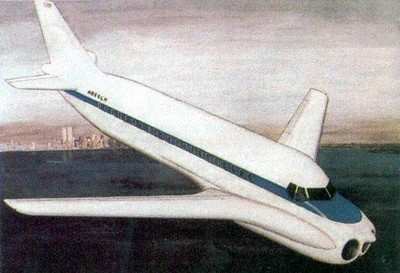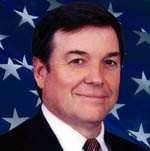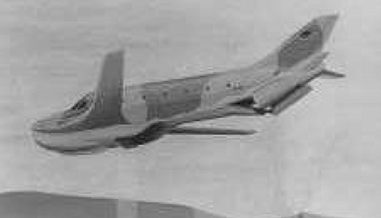Project Has Received $63M In Earmarks Over Almost Two
Decades
On paper, it looks really good. An inexpensive VTOL plane with a
range of 5,000 miles and a top speed of 700 mph, capable of
carrying 48 fully armed soldiers and a Humvee. What general
wouldn't want to have seen such a tool on the battlefield?

Turns out, all of them. The DP-2, made by duPont Aerospace, has
been funded by Congress since 1988 and has yet to even fly higher
than a few feet. It has risen off a trailer during tethered
flights, before settling back down hard. The military has long held
it would never live up to the company's claims, and it never even
wanted the aircraft in the first place.
Congress has been funding this aircraft's development since its
inception even after failing test after test... and the Pentagon
has repeatedly questioned its feasibility and criticized the
contractor's work, according to the San Diego Union-Tribune.
The project's staunchest supporter and guaranteed funding source
is Duncan Hunter (R-CA) who has been forced to defend his stubborn
refusal to stop earmarking funds for a program that apparently has
no merit as the program has come under close scrutiny in recent
weeks.
According to the Associated Press, not only did the Pentagon
decline to invest money in the DP-2, so did NASA. But Congress,
under the guidance and insistence of Hunter, has shelled out $63
million dollars in support so far despite studies by NASA and the
Pentagon finding fault with the whole project. He is proposing an
additional $6 million for the 2008 fiscal year.
Hunter, a 2008 Republican presidential nomination hopeful, has
been rewarded for his decades-long support with $36,000 in campaign
contributions, as reported by ABC News. Hunter calls allegations of
impropriety a "cheap shot."
 "I think it's worth it
to every Marine in Afghanistan and every Marine in Iraq to try to
do the very best we can to develop good technology," said
Hunter (right). "I do what I think is right for the
country."
"I think it's worth it
to every Marine in Afghanistan and every Marine in Iraq to try to
do the very best we can to develop good technology," said
Hunter (right). "I do what I think is right for the
country."
"This project is just fraught with problems," responds North
Carolina Representative Brad Miller, who chaired a hearing on the
DP-2's continued funding by the House Science and Technology
Committee's investigations and oversight subcommittee. "Should we
continue to fund this, or is there an accountability by
Congress?"
Hunter says the DP-2's concept is "extremely difficult to
achieve but extremely valuable."
"The Pentagon doesn't come up with every great idea," said
Hunter.
"There's not a bird on the runway today ... that we developed in
four years," he said. "You don't develop anything in four
years."
Miller notes the aircraft "is still not operational and has
never received a positive technical review in more than 20 years.
Congress appears to have permitted the DP-2 program to become a
hobby, not a serious research project."
This situation is bringing earmarks back into the public eye.
Earmarks are line items that are inserted by individual congressmen
into a spending bill that requires no public debate, discussion or
disclosure. They are used to fund things like new roads or defense
contracts to benefit their constituents.
Hunter defended earmarks, saying they play a "vital role" in
research and development projects, according to ABC News. "A lot of
them fail, but a few of them break through, and the ones that break
through prove of great value," said Hunter.
Hunter has sponsored earmarks for DuPont before, as well as for
many other San Diego-based defense contractors and was chairman of
the House Armed Services Committee.
California Representative Dana Rohrabacher, a
Republican member of the House Science and Technology
Committee, hailed duPont president Tony duPont as "a respected
engineer" and "a maverick."

"When we come to the point where we don't (give) mavericks and
free thinkers the chance to prove their theories, we're putting a
great limitation on what our potential is for the future," said
Rohrabacher.
John Eney is an aerospace engineer who headed up the aircraft
conceptual design group at the Naval Air Development Center Naval
Air Systems Command. He led an onsite review of the DP-2 program in
1999.
"It's a pipe dream," he said.
In order to have the promised VTOL capabilities, the aircraft
directs jet exhaust toward the ground. Eney says this would
incinerate troops rappelling out of the aircraft.
Hunter "failed to understand the basic physics of this
situation," he said.
DuPont also testified at the hearing through a video link from
San Diego. He disputes this line of thought, saying the jet exhaust
would have a "low enough temperature" that to troops exiting the
aircraft it would be "like wading in a trout stream."

"To continue to fund it would be an insult to the aerospace
industry at large and to the taxpayers," Eney testified.
The general consensus of witnesses who testified before the
panel was duPont was no closer to delivering on the promises made
about the DP-2 than it was in 1988. "There have been four accidents
in the last four years," said Miller. "The good news is that when
it crashes, it only crashes from a foot or two off the ground."
 NTSB Final Report: Cozy Cub
NTSB Final Report: Cozy Cub ANN FAQ: Contributing To Aero-TV
ANN FAQ: Contributing To Aero-TV Classic Aero-TV: Seated On The Edge Of Forever -- A PPC's Bird's Eye View
Classic Aero-TV: Seated On The Edge Of Forever -- A PPC's Bird's Eye View ANN's Daily Aero-Linx (04.29.25)
ANN's Daily Aero-Linx (04.29.25) ANN's Daily Aero-Term (04.29.25): Execute Missed Approach
ANN's Daily Aero-Term (04.29.25): Execute Missed Approach






